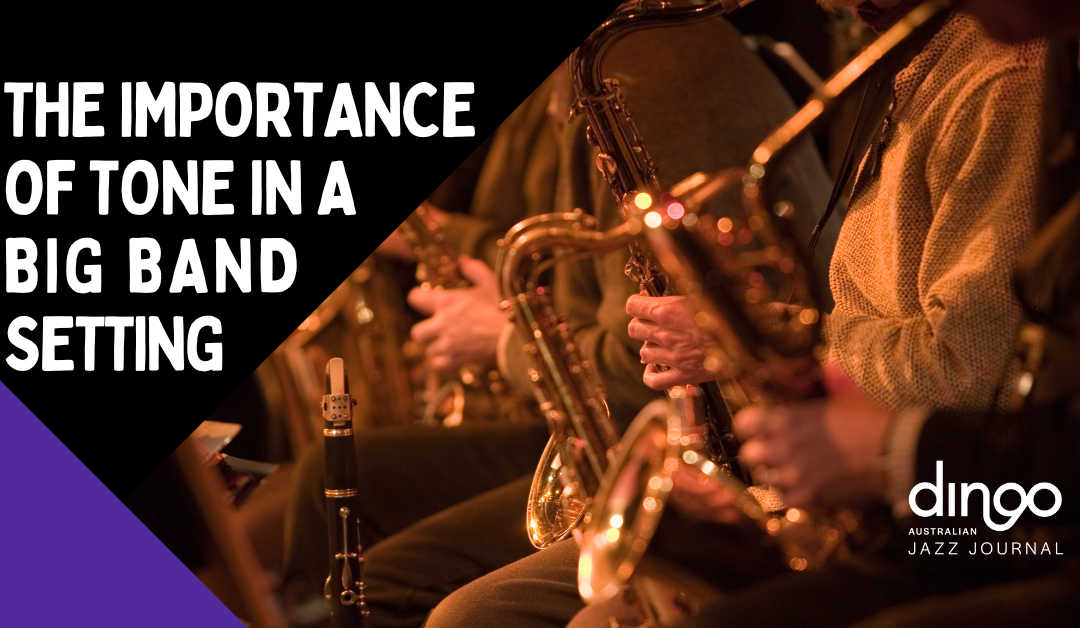This article was first published in Dingo Issue 2, October 2021.
Toshi Clinch
Co-Founder & Managing Director of Jazz Melbourne
Directing a big band can be an intimidating task for many and is potentially hard to navigate due to the ability of the ensemble or personal musical background. However, many musical characteristics cross genre and style, and can give us an advantage when rehearsing a large jazz ensemble. Out of all the characteristics, tone plays a pivotal role in shaping a band, where it can set the foundation for all other components. But what is tone? What is a favourable tone? And are there multiple “good” tones?

Simply put, tone is the culmination of technique and timbre, resulting in a sound which is favourable to the ear. Depending on your particular taste in music, different tones may appeal to you more so than others. Fortunately, we have close to a century of recorded big band music to help us with establishing what a “good” tone is for this setting. By focusing on this one area, we can create a solid base for the ensemble to sound good regardless of their technical ability, providing the perfect stepping stone to more common rehearsal points such as intonation, rhythm and balance.
Often when a person begins playing an instrument, one of the first areas that is focused on is their tone. This is because as educators we try to establish the importance of creating a good sound on the instrument before revealing more complex aspects of music to our students. However, many times in a band setting we find ourselves focusing on note accuracy, rhythm, and intonation as they are easier to critique.
Of course these are all valid areas of concern, but by disregarding tone we can be potentially creating further issues in the future. In my experience as a school big band clinician, I often find senior bands that are technically efficient but still sound like an amateur ensemble. In almost all cases this is because the musicians are unable to distinguish whether they are playing with a favourable tone. It is important that we treat an ensemble similarly to that of a new student, going slowly to establish a good initial tone even if that means delaying progress in other areas. No matter what repertoire the band is learning, by focusing on tone production you are guaranteeing that the ensemble as a whole will generate a favourable sound.
Now that we have established the importance of tone in an ensemble setting, how can we improve it practically? There are many ways to go about improving the tone of both an individual and a band, but at the core it is critical that the director has an understanding of what a good tone sounds like. This can come from many different areas, but by listening to established musicians perform you will have at least one reference point to reflect back on to. From here we can use this foundation to assist our own students. In an ensemble setting the simplest exercise is to have the band play a tuning note. Aside from focusing on intonation, by holding one note it is easy to assess the tone of the whole ensemble as well as individually. If they play a note which has good tone you can move on, but in the case where there are issues, you can expand the exercise. Question the band about whether they are playing with good tone, and use their responses to gauge whether they are critically listening to the notes they play. It is essential that each member is actively engaged in their tone production to guarantee the best ensemble results. From there, identify the members with problematic tones and help them solve what might be causing the issue. In almost all cases this will come down to either a technical problem, a gear problem, or not having a tonal reference point. If you do not feel comfortable with a particular instrument, have a colleague help who does. Ideally this exercise would be repeated at the beginning of each rehearsal until it is clear that all members can hear their own tone and adjust where necessary.
As a result of focusing on tone first, you will allow the students to not only perform better, but also understand one of the most critical areas of music. It paves the way to work on more complex areas, with the previous exercise able to be manipulated to work on intonation, balance and blend. Not only will you see improvement in your own ensemble, you will be providing each musician with a set of skills that can help them create their own voice on their given instrument; ultimately setting up any ensemble with a solid foundation while also mapping out a trajectory where individuals listen deeper, analyse themselves, and think critically.

